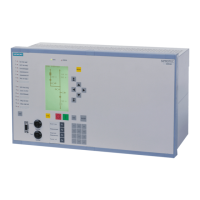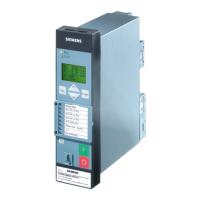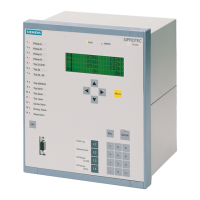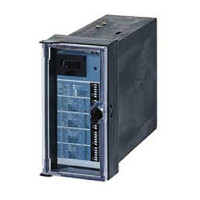NOTE
If via parameter 251 CT Connect. one of the current transformer connection types A,G2,C,G; G->B or
A,G2,C,G; G2->B has been selected, the measured ground current Ι
N2
measured by the second current
transformer is indicated under track “iN”. The ground current detected by the fourth current transformer is
indicated under track “iNs”.
Setting Notes
Configuration
Fault recording (waveform capture) will only take place if address 104 OSC. FAULT REC. is set to Enabled.
Other settings pertaining to fault recording (waveform capture) are found in the Osc. Fault Rec.
submenu of the SETTINGS menu. Waveform capture makes a distinction between the trigger instant for an
oscillographic record and the criterion to save the record (address 401 WAVEFORMTRIGGER). Normally, the
trigger is the pickup of a protection element, i.e. the time 0 is defined as the instant the first protection func-
tion picks up. The criterion for saving may be both the device pickup (Save w. Pickup) or the device trip
(Save w. TRIP). A trip command issued by the device can also be used as trigger instant (Start w.
TRIP), in this case it is also the saving criterion.
A fault event starts with the pickup by any protection function and ends when the last pickup of a protection
function has dropped out. Usually this is also the extent of a fault recording (address 402 WAVEFORM DATA =
Fault event). If automatic reclosing is performed, the entire system fault — with several reclosing attempts
if necessary — can be recorded until the fault has been cleared for good (address 402 WAVEFORM DATA =
Pow.Sys.Flt.). This facilitates the representation of the entire system fault history, but also consumes
storage capacity during the automatic reclosing dead time(s).
The actual storage time begins at the pre-fault time PRE. TRIG. TIME (address 404) ahead of the reference
instant, and ends at the post-fault time POST REC. TIME (address 405) after the storage criterion has reset.
The maximum storage duration of each fault record (MAX. LENGTH) is entered at address 403. Recording per
fault must not exceed 5 seconds. At least 8 records can be saved altogether with a minimum total time of
20 s .
An oscillographic record can be triggered by a status change of a binary input, or from a PC via the operator
interface. Storage is then triggered dynamically. The length of the fault recording is set in address 406 BinIn
CAPT.TIME (but not longer than MAX. LENGTH, address 403). Pre-fault and post-fault times will add to this.
If the binary input time is set to ∞, the length of the record equals the time that the binary input is activated
(static), but not longer than the MAX. LENGTH (address 403).
Settings
Addr.
Parameter Setting Options Default Setting Comments
401 WAVEFORMTRIGGER Save w. Pickup
Save w. TRIP
Start w. TRIP
Save w. Pickup Waveform Capture
402 WAVEFORM DATA Fault event
Pow.Sys.Flt.
Fault event Scope of Waveform Data
403 MAX. LENGTH 0.30 .. 5.00 sec 2.00 sec Max. length of a Waveform
Capture Record
404 PRE. TRIG. TIME 0.05 .. 0.50 sec 0.25 sec Captured Waveform Prior to
Trigger
405 POST REC. TIME 0.05 .. 0.50 sec 0.10 sec Captured Waveform after Event
406 BinIn CAPT.TIME 0.10 .. 5.00 sec; ∞ 0.50 sec Capture Time via Binary Input
2.1.4.2
2.1.4.3
Functions
2.1 General
SIPROTEC 4, 7SJ62/64, Manual 49
C53000-G1140-C207-8, Edition 08.2016

